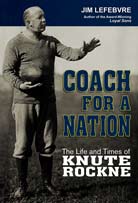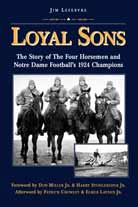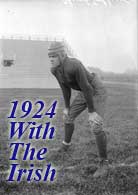Captain of ’57 Squad Recalls How Irish
Bounced Back From Losing ’56 Campaign
What does it take for Notre Dame to rebound from one of its worst two-season stretches in school history?
The answer may lie in fundamentals.
[ND historians true to statistical accuracy will point out that the 2007 and 2008 seasons do not – as has been repeated ad infinitum by national media – constitute the worst two-year period in Irish history. The 2007-08 record of 10-15 is good for a .400 winning percentage. The 2-8 1960 season, combined with either the 1959 or 1961 campaigns, both 5-5, computes to a 7-13 record and .350 percentage.
[Similarly, the 3-9 2007 season (.250) is not the worst in school history, percentage-wise. That dubious distinction goes to 1956 and 1960, both 2-8 for a .200 winning percentage.]
The 1956 season stands alone, though, in the sense of its shocking nature. The Irish had not had a losing season in the past 22, dating back to the 3-5-1 mark of 1933.
In ’56, coach Terry Brennan was entering his third year at the helm and coming off an 8-2 mark in 1955, when the Irish finished ninth in the final AP Top 20 balloting. ND took a No. 3 national ranking into its opener, a night game at Southern Methodist. The Mustangs rallied for a late score and a 19-13 victory, and the pattern for the season was set.
Two weeks later, Purdue nicked ND 28-14 at Notre Dame Stadium, and the 1-2 Irish then were blasted by the top two teams in the land — #2 Michigan State (47-14) and #1 Oklahoma (40-0). Later, the #3 Iowa Hawkeyes laid a 48-8 licking on Brennan’s boys.
The season was made historic when all-purpose quarterback Paul Hornung won the Heisman Trophy, still the only winner from a losing team to be so honored.
Ed Sullivan, starting center in 1956 who would go on to captain the ’57 Irish, said the team never lost its fire, even with mounting losses.
“In ’56, it wasn’t that we ever were down, or thought, ‘Oh no, here we go again,” said Sullivan, who has resided in South Bend for decades. “We went into every game fully expecting to win. But one thing or another would happen, and we’d get knocked off. Hornung did a great job trying to carry the team, and overcome our weaknesses.”
One factor Sullivan cited was a lack of all-out scrimmaging.
“We had a younger team (in 1956), and it was felt there wasn’t a great deal of depth,” Sullivan said. “The coaches let up on scrimmaging, fearing for injuries. So we hit tackling dummies all week. Only come Saturday, those ‘dummies’ hit back, and moved in different directions that we weren’t used to from practice. And once that happens, it’s hard to adjust to.”
Sound a little like the young Irish of 2007 and 2008, with limited depth especially on the offensive line?
As Sullivan notes, with all the current talk about skill positions, athleticism, schemes, some things remain the same.
“Football, then and now, is still a game of fundamentals,” he notes. “You have to know how to block and tackle. And the only way to become proficient at that is to do it. Repetition. Day after day.”
When the Irish came back for the 1957 season – without Hornung – they had a changed attitude. Greater dedication. A certain toughness. And more physical practices.
The result was a 7-3 season and a No. 10 national ranking, along with one of the most memorable victories in ND history – the 7-0 triumph at Oklahoma on Nov. 16, 1957, which broke the Sooners’ record 47-game winning streak.
Does Sullivan see a similar rebound for the 2009 Irish?
As a former player, he’s been invited to a couple of practices, and likes what he sees.
“The physical battles are there, the No. 1 lines going up against each other, full-out contact and tackling to the ground,” he says. “Yes, you risk getting a few people nicked up along the way, but the preparation for game-day intensity is much more effective.
“Yes, it’s great to attract high-level recruits to Notre Dame, kids who know the sacrifices that need to be made to succeed at a place with high expectations, academically and athletically.
“But once here, they need to be challenged to become the best they can be. And that happens only on a day-after-day basis, going up against other talented players.
“To me, it seems like that is what’s happening now.”
Like all Irish fans, he’ll find out in just a few days.






